
The InARTE Journal’s 11th issue was made possible thanks to the work of our Graphic Designer Jean-Philippe Poirier, our Social Media Coordinator and Meditation Instructor Aná Dafré, Assistant Editor Andrea Rosati, Editor Morgane Poezevara-Stevens, Managing Editor Tricia Enns and with the support of our Faculty Advisor, Kathleen Vaughan. With the unique abilities of each of our team members, the Journal was able to host a multitude of amazing online events that brought the Art Education and Fine Arts community together during the pandemic, when physical interaction wasn’t possible. By the power of online connection, the InARTE Journal was able to partake in a community check-in, a midterm survival stretch and meditation event, as well as a celebratory ‘5 à 7’ open studio prior to final critiques. This year’s accomplishments are truly all thanks to the hard work of our team members who brought life, joy and creativity into the production of our 11th issue!
With COVID-19 necessitating transition into online learning and our finding new ways to adapt to our socially distanced environment, the theme ‘Interaction’ seemed fitting for this edition of the Journal. We complement the Journal’s on-going presentation of undergraduate work with Synergy, a month-long, multimedia virtual exhibition that investigates and explores the different ways in which we interact with our environment and community as artists and art educators, and that features works of seven Fine Arts students at Concordia. Synergy is the product of collaboration, combining each participant’s unique talents to work together towards a common goal. Showcasing lesson plans, paintings, drawings, music and sculpture, the exhibition — like this issue of the Journal itself — frames the theme of interaction through diverse perspectives. View the online exhibition here.
Sincerely,
The 11th edition InARTE Journal Team
Penny Paris (she/her)
4th year, Art Education Specialization
Daily Moves
Lesson plan
Artist statement:
Footways, paths and choices. Layered images and transformed or projected impressions. Through a variety of mediums, I enjoy displaying those last moments, contacts and relationships to beings or spaces that are no longer here.
I am an Art Educator and have been teaching for the past eleven years. As I challenge my students to see where their work will bring them, I am also influenced by their interests and needs when expressing their ideas.
My work meanders through explorations on a recurring theme “Where am I going” or “What can I try-discover”. Through a highly playful process and a willingness to experiment, my work is created by editing, altering and varying imagery. Seriality allows me to favor mark making and materiality.
At the center of my work are environments in flux. Playing off of naturescapes, there’s stillness in liminal space, pauses and gaps but also transformation. I enjoy questioning what is seen or perceived and the role the spectator plays when viewing and interacting with my artistic wanderings.
Description of the work:
This is a lesson plan developed around the integration of technology into our Educational Art Practices. On top of developing art skills, students are encouraged to express a narrative by means of a GIF animation and communicate their initial intention as well as assess their artwork using art specific vocabulary.
Interaction is central in both the creation and evaluation processes by using a mix of self-assessment, formal evaluations and reflections. Self-assessments will be used to determine if the artwork is progressing, compare the student’s chosen intention with in-progress and finished artworks as well as to develop a creative practice. Formal evaluations will be used to grade technical skills and application of assignment criteria in students’ artworks as well as to evaluate the use of acquired vocabulary. Reflections will be used to generate ideas, discuss concepts introduced as well as formulate responses to questions posed throughout the lesson.

Daily moves – Lesson Plan
https://docs.google.com/presentation/d/1v0oL8Mt_K3kGZpzI38Skwi5F2-ntW5WfGaaJyZ0tm38/edit?usp=sharing
Grade Level/Course: Grade 8 – Arts Lesson Time Frame: 4 classes of 75 minutes.
Context of learning: For the end of December and beginning of January students will be at home and taught through an online platform. They will not have access to any of the art materials that are available in the classroom and there is not enough to lend to every student. They do have a sketchbook and pencils that were purchased at the beginning of the year as well as a computer and access to a digital camera at home.
Rationale: Teenagers use various means of communication. One of these is texting using a digital device. From the use of words, to text abbreviations and emojis, this form of communication has evolved in order to more accurately express what the writers mean to say. In more recent years,
there has been a rise in the use of GIF animations to further convey the writers’ actual message, expression or feelings. Yet how do you illustrate and animate movement or expressions? How do you create these three to ten second snapshots that convey information, engage your audience and tell a story?
In order to develop their communication skills, as well as appropriate a popular digital medium, students will delve into the world of digital animation. Through the use of digital photography as well as traditional drawing, we will discover how to tell a story, explain a process or even showcase our personality using a simple digital animation method: the GIF animation.
Question of Inquiry: How do you communicate through animations?
Art Lesson Outcome: Students will create animated GIFs.
Learning Objectives
Students will:
• draw multiple drawings that illustrate a movement and in order to create an animated GIF. • shoot photographs and use sequence photography in order to use these images in photoshop to create an animated GIF.
• demonstrate the use of the following technical tools: importing images into photoshop onto different layers, creating and using a timeline, creating a frame animation, looping an animation and exporting a timeline to create a GIF animation.
• express a narrative by means of a GIF animation.
• communicate their initial intention as well as assess their artwork using art specific vocabulary.
Acquired knowledge and skills:
In previous art lessons students have learnt how to:
• navigate Google Classroom.
• use Google Meets.
• share a screen on Google Meets.
• upload an image onto their individual Google Drives.
• rename files.
• resize and crop images. (I will probably have to go over these again)
• draw parts of the face: eyes, ears, mouth and nose.
• shade drawings.
• use light (light table or a window) to trace an image from one drawing to another. • use registration marks.
• frame an image using a digital camera.
• work with basic file formats (jpeg, png).
New knowledge, skills, vocabulary and concepts to discover, understand, demonstrate and/or use throughout the art lesson.
Vocabulary
Frames and frame rate
Image Resolution
Exporting
Stills vs clips
Layers
Timeline
To loop an animation
GIF, png, jpeg.
Key Poses
Educator Materials / Equipment
Visual presentation for the lesson GIF examples
Drawing examples
Photography examples
Prototype, sequence of images Vocabulary references
Tutorials and references
Google Classroom, Meets Photoshop
Concepts
Burst images in animation – images en rafale Sequence Photography
Narrative in animation
Movement in animation
Contrasting static background with moving element of image/animation
GIF past and present
Evolution of GIF in culture and communications Structure of timelines and duration of stills
Concepts
Burst images in animation – images en rafale Sequence Photography
Narrative in animation
Movement in animation
Contrasting static background with moving element of image/animation
GIF past and present
Evolution of GIF in culture and communications Structure of timelines and duration of stills
Student Materials / Equipment
Sketchbooks
Pencils and erasers
Light source (can use a window or other transparent surface that lets the light source through).
Digital camera (phone, camera, tablet…) Computer
Online access time
Google Classroom and Meets
Photoshop
Diverse learners
This lesson is conceived, sequenced, scaffolded, illustrated, supported and delivered with diverse learners at the forefront of considerations. (See Diverse Learners – Considerations for details.)
Lesson Sequence
This lesson is broken up into 4 classes of 75 minutes. It is supported by a slide presentation that refers to presenter notes. These notes include guidelines to follow, questions to ask, approach to use as well as a timeline to refer to throughout each class.
Class 1 Tasks
15 mins – Group Activity: Question about effective communication, what is communicated and how art class relates to digital artists. How and why are GIFs relevant to us as individuals? Fundamentals: Cover basic knowledge of what is a GIF, its origins and specific vocabulary.
25 mins – Work Time: Students will draw multiple drawings
Working from previously explored parts of the face students choose what they want to illustrate, trace images in order to keep continuity and express chosen intent. Go through guided steps to break down movement. Cover Key Poses and in-between…
15 mins – Troubleshooting Teacher discussions with small groups or individuals.
10 mins – Documenting and set-up for next class.
Tell them where we are going with digital photography, what tools we will need and set work expectations (images done… or just about depending on when the next class is…)
Question of inquiry: How do you communicate through animations?
Outside of class: Reflection for next class: Short answer videos (60 to 90 secs reflections uploaded to their individual folders.) Answer question of inquiry as well as: What do they intend to communicate?
Class 2 Tasks
15 mins – Group Discussion:
How do you communicate through animations? – Sharing recorded answers. What does loop effect create? Introduce to nuances of communication.
Use artist work to guide them through reflection.
Tutorials: Go over vocabulary with them. Ask questions to verify understanding… Layer= cake, ground, clothing when cold…
Frame=1 image in a sequence of images in animation
Looped=never ending, circle, oval race track,
Exported=Exit from program/app – taking creation with them
Choice of Tutorial to use, show references: Show the group what each tutorial looks like, where to find the information (Google Classroom) what the information contains and how to use it. DO NOT go over every detail just yet.
Can show them the tiny short one as an example.
25 mins – Work Time: Students will create GIFs from photographs of drawings.
Key guidelines: Frame every image you draw (centered)
Save onto Drive (or upload to Drive)
Rename each image in order of desired sequence
Let students go through tutorial steps to work in Photoshop.
15 mins – Troubleshooting
Teacher discussions with small groups or individuals. Tell group when moving to a break out session on specific subjects.
10 mins – SAVE WORK and set-up for next class.
Tell them where we are going with sequence photography, what tools we will need and set work expectations (photos done, GIF animation functional tests…done work??)
Question of inquiry: How do you communicate through animations?
Reflection for next class: Short answer videos (60 to 90 secs reflections uploaded to their individual folders.) Answer question of inquiry as well as: How their work looks so far? What type of adjustments do they think need to be done?
Class 3 Tasks
5 mins – Set-Up Get class ready to start
25 mins – Troubleshooting and Work Time
Cover some basic or recurring problems with class.
Teacher discussions with small groups or individuals. Troubleshoot out loud with group on mute to work through recurring problems. Tell group when moving to a break out session on specific subjects.
30 mins – Work Time
Bring group back to question of Inquiry: How do you communicate through animations? A few answers as a group. Bring students to reflect on Sequence Photography – Burst images and Animation. What is this image communicating?
How could this apply to our art projects: creating GIF animations.
How many “Frames” or “Shots” do they see?
Going over the Basics (same principles as drawings).
What are we going to create from the photographs we will take?
Why works? Why it doesn’t?
Ask students what do they think will work? (What kind of expression? Short and simple!) What do they think they will need? (Tools, camera, computer, …)
Go over some basic technicalities built on prior knowledge. (How many pictures? Framing? Still background?)
10 mins – Assessment
Tell them where they can find the assessment rubrics, sheets and evaluations. Also, cover what they will need to reflect on and set work expectations (photos done, GIF animation functional covered and first tests?? Will finish work next class.)
Question of inquiry: How do you communicate through animations?
Reflection for next class: Short answer videos (90 to 180 secs reflections uploaded to their individual folders.) Answer question of inquiry as well as: How their work looks so far? What type of adjustments do they think need to be done? What do they intend to communicate with photography-based GIF? How is their device working to take pictures?
Class 4 Tasks
15 mins – Troubleshooting the Tutorials: Help students through the work to be done.
30 mins – Work Time: Time to get tasks done. Work with students and see what needs to be one.
20 mins – Assessment & Reflection: Cover Self-Assessment of technical work and Reflection on process. Remind them to record reflection for next class: Short answer videos (180 secs reflections uploaded to their individual folders).
Answer question of inquiry: How do you communicate through animations? How does your work look? What did you communicate? What works and/or doesn’t with your animations? Open question: About effective communication, what is communicated and how art class can be a fun, safe, open, … space to explore many means of communication.
Evaluation
The evaluations will be a mix of self-assessments, formal evaluations and reflections.
Self-assessments will be used to determine if the artwork is progressing, compare student’s chosen intention with in-progress and finished artworks as well as to develop a creative practice. The self assessments will be short self-recorded videos of student’s thoughts on specific subjects, questions and themes that are then saved on their individual Drives.
Formal evaluations will be used to grade technical skills and application of assignment criteria in student’s artworks as well as to evaluate the use of acquired vocabulary. Formal assessments will be done in rubric format, with four levels per demonstrated skill.
Reflections: will be used to generate ideas, discuss concepts introduced as well as formulate responses to questions posed throughout the lesson. These will either be recorded using videos, written online (shared document) or conducted via Google Meets with teacher.
Evaluation criteria for:
Draw multiple drawings: Similarity between drawn images (tracing and overlay).
Sequence photographs: Framing used to reinforce movement (stability of background and framing of main subject).
GIF animations: Looped animation (2 to 5 seconds), continuity of illustrated and photographed movements (+/- 15 f/s), duration of frames reinforces intent of narrative (same time and /or variability of timing).
Express a narrative and communicate their initial intention: Use of art specific vocabulary, reflection on lesson’s concepts.
Dissemination
A group Drive will be used to share the different GIF’s with the other students in the class. Also, a looped video sequence of the GIF’s will be published on the school’s website (if appropriate and permitted by students, parents/guardians, school and schoolboard). I would love to have a class website where all artworks could be visible to the public.
Resources
Adobe Creative Cloud (2017, September 1) Emilie Muszczak Creates an Animated Self Portrait in Photoshop and Animate | Adobe Creative Cloud [Video]. YouTube. https://www.youtube.com/watch?v=cIKGQLG2tFY
Adobe Creative Cloud (2017, March 8) How to Create an Animated GIF in Photoshop | Adobe Creative Cloud [Video]. YouTube. https://www.youtube.com/watch?v=omdfcGYEqPY
Create an animated GIF from a series of photos. (2020, July 28) Adobe. Retrieved November 30, 2020 https://helpx.adobe.com/ca/photoshop/how-to/make-animated-gif.html
Création d’un GIF animé à partir d’une série de photos. (2020, October 3) Adobe. Retrieved November 30, https://helpx.adobe.com/ca_fr/photoshop/how-to/make-animated-gif.html
Galer, M. (2015, September 16). How to make an Animated GIF in Photoshop [Video]. YouTube. https://www.youtube.com/watch?v=Qtar5T13dt8
Stancikaitė, A. (2020). Aistė Stancikaitė. Retrieved November 26, 2020 https://www.stancikaite.com/
Newton, P. (2016, June 6). Animation for Beginners: How to Animate a Head Turn. Design & Illustration. Retrieved December 1, 2020, https://design.tutsplus.com/tutorials/animation-for-beginners-how-to animate-a-head-turn–cms-26487
References
(2018, January 10). 5 Reasons to You Should Be Using GIFs in Your Social Media Campaigns, Social Report. Retrieved November 26, 2020, from https://www.socialreport.com/insights/article/115005444323-5- Reasons-to-You-Should-Be-Using-GIFs-in-Your-Social-Media-Campaigns
Bakhshi, S., Shamma, D.A., Kennedy, L., Song, Y., de Juan, P., & Kaye, J. (2016) ‘Fast, Cheap, and Good: Why Animated GIFs Engage Us.’ CHI ’16: Conference on Human Factors in Computing Systems, San Jose, California USA May https://dl.acm.org/doi/10.1145/2858036.2858532
Jiang, J., Fiesler, C., & Brubaker, J.R. (2018). ‘The Perfect One’: Understanding Communication Practices and Challenges with Animated GIFs. Proceedings of the ACM on Human-Computer Interaction, 2(CSCW), Article No,: 80 https://dl.acm.org/doi/10.1145/3274349
Miltner, K.M., Highfield, T., Never Gonna (2017). GIF You Up: Analyzing the Cultural Significance of the Animated GIF. SAGE Journals: Social Media + Society, 3(3), 1-11.
Miltner, K.M., Highfield, T., Never Gonna (2017). GIF You Up: Analyzing the Cultural Significance of the Animated GIF. SAGE Journals: Social Media + Society, 3(3), 1-11.
https://journals.sagepub.com/doi/full/10.1177/2056305117725223
Oswald, V., (2013) Examples of Extreme Sequence Photography. Resource Magazine, Retrieved December 2, 2020, from http://resourcemagonline.com/2013/05/examples-of-extreme-sequence-photography 3/26539/
Reyes, M., Kaeppel, K., & Bjorngard-Basayne, E., (2018) Memes and GIFs as Powerful Classroom Tools. Teaching with Technology, Retrieved November 28, 2020, from https://www.facultyfocus.com/articles/teaching-with-technology-articles/memes-and-gifs-as powerful-classroom-tools/
Simmons, M., (2019, April 27). How to Make GIFS Using Still Photos in Photoshop. Matthew Simmons, Retrieved December 1, 2020 https://www.matthewsimmonsphoto.com/blog/2019/4/27/how-to-make-gifs-using still-photos-in-photoshop

Lucy Piper Giles Sharpe (she/her)
3rd year, Studio Arts
Philosophies of Pleasure
48″ x 60″
oil paint
Artist Statement:
Lucy Sharpe is an artist, student and cook living in Montreal. Her practice revolves primarily around mindful hedonism, as well as sex, cooking, feminism, intergenerational relationships and climate justice.
Description:
My work Philosophies of Pleasure investigates the way that indulgence allows us to more genuinely interact with one another. We are often taught to feel guilt about the things that make us feel good, and that guilt prevents us from genuinely engaging both physically and spiritually with those around us. By freeing yourself from shame, you are enabling yourself to interact with sincerity.
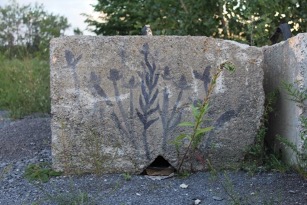
Natacha Girouard
Third Year, Specialization in Art Education
Connecting to Hybrid City Spaces
Series of Cyanotypes
2021
Artist statement:
I am a budding art educator with a background in outdoor education and studio arts. In my teaching/art practice, I incorporate recycled, repurposed and natural materials. I am interested in outdoor spaces as co-facilitators. I aspire to connect with local community organizations and schools to create opportunities for experiential learning, movement, risk-taking, and participant-led projects.
Description:
The submitted work is a reflection on a project done over the summer using cyanotype to connect/interact with to outdoor spaces in the city. The submitted work includes documentation (pictures) of the project and workshop given.
Cyanotype Project
Connecting to Hybrid City Spaces
How do you define connection; is it limited to people, or does it encompass self, city, earthly nature, and more?
During the summer break 2020, I set out to connect with my environment and art practice using cyanotype. By exploring the photographic process in situ, I hoped to change my relationship to familiar city spaces. I wondered if I could feel a deeper connection to the city and nature within it. To further experience cyanotype as a relational tool, I aimed to share my process and host an outdoor workshop while navigating the evolving pandemic health regulations.
If you are familiar with cyanotype, perhaps and a satisfying blue comes to mind. The Greek definition of cyan, a deep-blue impression, describes it well (Stulik & Kaplan, 2013). The process is low-tech and low toxicity; it uses two soluble powders (ferric ammonium and potassium ferricyanide) to create a photosensitive solution (Ware, 1998). When exposed to ultraviolet light and developed in water, coated paper turns deep blue. By hiding areas from exposure, compositions and images can appear. English physical scientist John Herschel discovered cyanotype in 1842 on his quest for a colour photographic process (Ware, 1998). Atkins’ botanic prints and photographic books Photographs of British Algae: Cyanotype Impressions (1843-53) are early examples of the technique and possibly the first photo-illustrated books (Stulik & Kaplan, 2013). Contemporary artists such as Megan Riepenhoff, Erin Shireff, and Andrea Chung have adopted and adapted the process with exciting results. Megan Riepenhoff creates abstract compositions by exposing large, coated sheets to the water, salt, and sand of American beaches. As photographers, artists and hobbyists embrace the blue, sourcing materials and information is increasingly accessible.
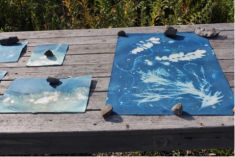
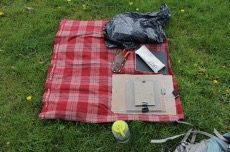
I was drawn to the medium’s directness, portability, low-cost, and potential for experimentation. Beyond the powders’ initial cost, I spent little on materials using left-over fabrics, paper, and cardboard. I pressed materials between old glass frames with clips to create sharper prints. Importantly, I could carry or bike all my materials using a backpack.
I chose three locations in Montreal/ Tiohtià:ke where nature and city structures interact: the Loyola City Farm, Projets Éphémères, and the Blue Bonnets Hippodrome. I frequently visited these spaces for work, solitude, and a sense of “the wild” within the city. In each location, I experimented with different natural materials, objects, and techniques. At the Loyola City Farm, I made prints from the compost pile and placed coated paper amongst the grasses and plants. At the Projets Éphémères gardens, I played with the effects of water, mud, and found objects. I used my apartment balcony to expose kitchen scraps, tea leaves, and ice cubes. These are just a few examples of how cyanotype drew me closer to these spaces and their materials. The process allowed for a sense of discovery and play. While making prints, I became more aware of each sites’ textures, moisture, and shapes. My awareness also turned to the sky, as changes in light greatly affected exposure. In full sun prints take about 15 minutes, while they can take hours with cloud-cover. The sun’s angle also affected prints by creating long shadows. The process permitted me to spend hours at a time in these spaces, present and focused. It felt a lot like “connecting”. The prints produced stand as collections or snapshots of my interactions with these spaces.
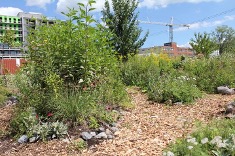
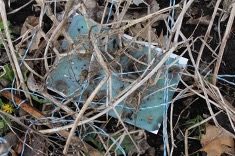
I was eager to share my experience of these hybrid nature/city spaces with others but, hosting a workshop during the pandemic made me anxious. I went ahead following the most up-to-date health regulations and invited four friends to the Projets Éphémères gardens. Projets Éphémères started as a gravel lot granted by the University de Montréal for community gardens and urban agriculture nearly six years ago (UdeM, 2021). It has been criticized as an effort to increase UdeM’s new campus’ social acceptability, located in the Parc-ex neighborhood (Colpron, 2019). Over the years, community organizations have built-up the soil and it now supports a diversity of insects, birds, fruit trees, herbs, and vegetable gardens. Projets Éphémères is, however, temporary and planned for demolition in the last phase of building the new campus.

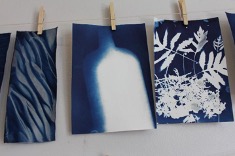
I began the workshop with a quick tour and introduction followed by an exercise to “tune-in” to the site and our senses. Each participant chose a unique spot to sit alone and answer a list of questions in their sketchbooks. The questions, inspired by awareness practices, included: What are the furthest and nearest sounds you hear? What do you smell? What attracts your eyes? Etc. Participants jotted their answers and sketched the space around them. Some drew detailed plants and city structures, while others created sound maps. We regrouped, reflected on our experiences, and read harvesting best-practices by Potawatomi biologist and writer Robin Wall Kimmerer (Kimmerer 2014). We then dispersed to harvest plants and objects for our prints. Following demonstrations, participants made and developed several prints. Once everyone had gained first-hand experience with the process, I suggested making collaborative cyanotypes. I had brought some large, coated papers for this purpose. Participants became more experimental and less product-oriented while collaborating; many said it was the highlight of their day. We ended the workshop by putting objects back where we had found them, scattering plants and seeds, and reflecting on the experience. Four hours had gone by in a flash. Most participants said they felt energized and inspired to try this process in other spaces.
My final experiments with cyanotype were spontaneous graffiti on cement blocks at the Blue Bonnet Hippodrome. I drew plants that echoed the ones piercing through the gravel at the blocks’ base. I enjoyed how the drawings appeared slowly with exposure and looked like shadows. Days later, the blue faded and was washed away by rain. For me, appearing and disappearing represents the natural world (the more-than-human) within the city. As explained by Alette Willis (2011), the wild and the urban are interpenetrating; cities are (to varying extents) hybrid places where humans, natural elements and structures interact. According to Willis, nature does not need to be separate from the urban or the human. She asks whether we can heal ourselves by restoring and creating access to natural spaces within cities (Willis, 2011). This perspective resonates with me and my experience of hybrid city spaces. However, ecologically diverse urban spaces are few and cannot be taken for granted as both the Projects Éphémères gardens and the Blue Bonnets Hippodrome (OCPM, 2020) are slated for urban development and construction.
The current pandemic has changed our lives, plans and outlook. Limited in-person interactions have pushed me to recognize connection as a priority. I now know that “feeling connected” is why I enjoy facilitating and teaching. I have also learned that connection is broad and can include connecting to my environment, the more-than-human, myself, spirituality, and history. Perhaps connection is adaptable, situational. By connecting to hybrid natural/city spaces using cyanotype, I felt the calm and timelessness of a nature walk without leaving the city. Is life the same? No, but maybe finding new means of connecting is valuable in its own way.
Documentation and lesson plan available at https://natgirou.wixsite.com/cyanotypeproject
This project and writing took place in Tiohtià:ke/Montreal on Kanyen’kehà: ka territory.
Thank you, Dr. Laurie Blair for guidance on this project. Thank you, Camille S., Isabel, Camille D., and Johanna for participating in my first cyanotype workshop.
References
Colpron, S. (2019, June 30). Embourgeoisement : Parc-ex sous tension. La Presse. https://www.lapresse.ca/actualites/grand-montreal/2019-06-30/embourgeoisement-parc-extension-sous-tension#
Kimmerer, R. W. (2014). Returning the gift. Minding Nature, 7 (2), 18-24. https://www.humansandnature.org/filebin/pdf/minding_nature/May2014_Returning_the_Gift.pdf
Office de Consultation Publique de Montréal (OCPM). (2020). Rapport de consultation publique quartier Namur-Hippodrome. https://ocpm.qc.ca/sites/ocpm.qc.ca/files/pdf/P107/rapport-namur-hippodrome.pdf
Stulik, D. C. Kaplan, A. (2013). The atlas of analytical signatures of photographic processes: Cyanotype. The Getty Conservation Institute. https://www.getty.edu/conservation/publications_resources/pdf_publications/pdf/atlas_cyanotype.pdf
Université de Montréal (UdeM). (2021). Accueillir les communautés avoisinantes. Université de Montréal. https://www.umontreal.ca/universite-citoyenne/projets-ephemeres/
Ware, M. (1998). Herschel’s cyanotype: Invention or discovery? History of Photography, 22 (4), 371-379. https://doi.org/10.1080/03087298.1998.10443901
Willis, A. (2011). Re-storying wilderness and adventure therapies: healing places and selves in an era of environmental crises. Journal of Adventure Education & Outdoor Learning, 11 (2), 91-108. https://doi.org/10.1080/14729679.2011.633375
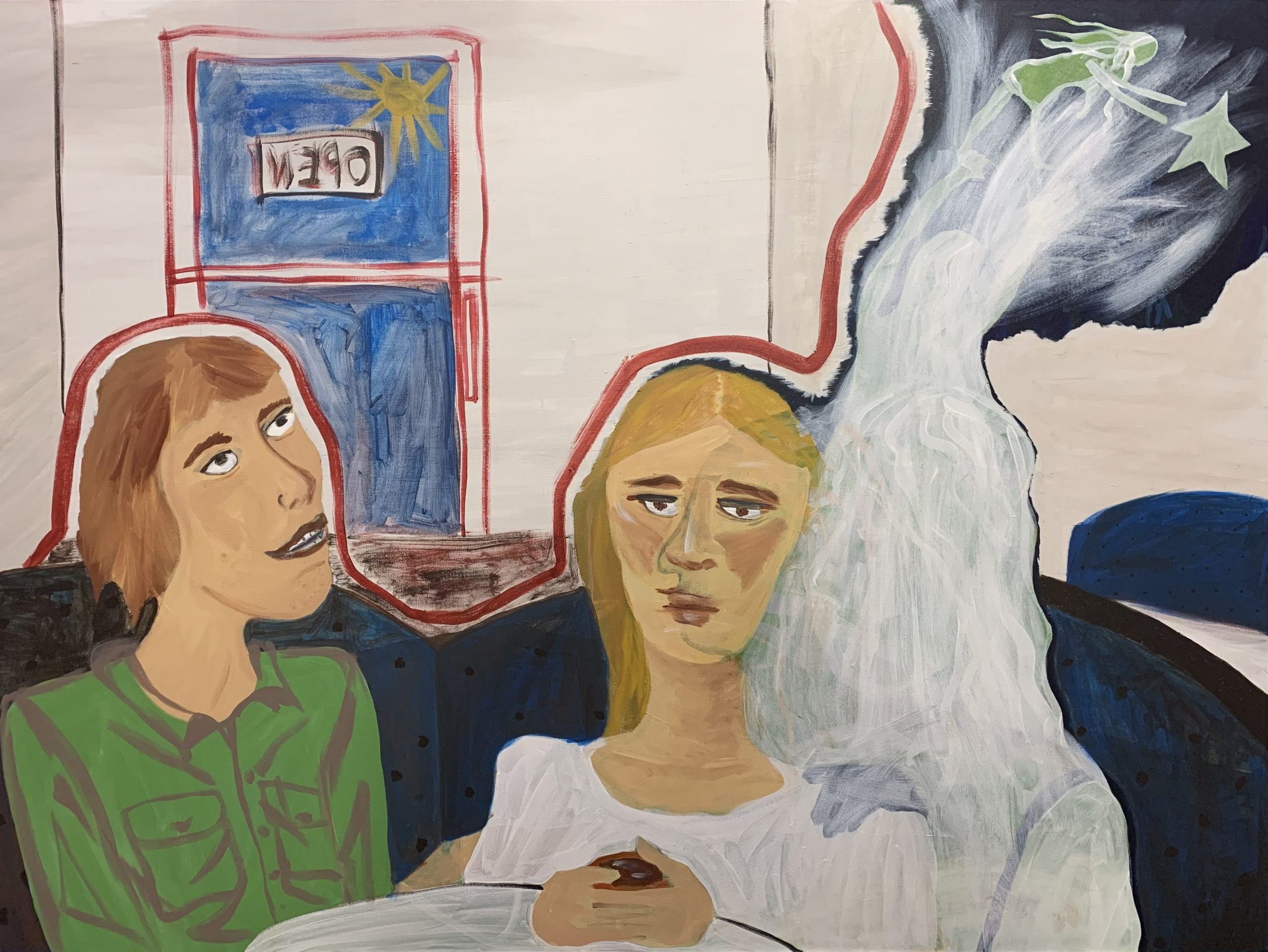
Davita Guslits (she/her)
3rd year, Painting and Drawing major
Trying to Come Back
4′ x 3′
acrylic and glitter on canvas
2020
Artist Statement:
Davita Guslits is a Fine Arts and Psychology undergraduate student at Concordia University, and has been practicing visual art for the past 12 years. Her main mediums are painting and film, which sometimes intersect with her other main interest: composing music. Davita is from a settler Ashkenazi Jewish family, living on Dish with One Spoon Treaty territory. Her recent works reflect the growing pains of extracting personal identity from internalized stereotypes, as well as her mounting interest in art therapy.
Description:
Daydreaming while on a Tinder date means you won’t really get to know the other person, and they likely won’t live up to the daydream anyway. This painting comes from a body of work examining personal accountability. Dating apps are a resented part of my life, despite the short term rush of matching with someone- but it doesn’t feel like they’re leaving my life anytime soon. The speed of matching and meeting potential dates belies the significant process of actually getting to know a new person, and the collective deprecation of these blind dates makes it difficult to take them seriously. But on reflecting, every date I daydreamed through meant a human being’s time and dignity being wasted on the other side of the table.
David Allen Dafré (he/him)
1st year, music major
It Is Too Little Time
audio recording produced by singer/song writer David Allen Dafré, 4:04 mins
2020
Artist statement:
Those who know of David Dafré’s musical past in Brazil might think of his return to school as a side project. For the body of work he accomplished with his band formed bridges across the continental nation in South America. Tirelessly touring, creating new material and bringing music to remote municipalities gained the band nationwide recognition and offered a myriad of experiences in the Brazilian Music Industry. But there was still one bridge left to construct. The bridge that connected his home country with the country that so kindly encouraged his musical experiments. How could the two hemispheres become one? In 2018, David returned to establish residence in the peaceful city of Montreal. He spent a little over a year flying to Sao Paulo and back for performances and recordings in Brazil. He was able to record and launch an album with his bandmates during that time. While in Montreal he would spend time with his family trying to make up for the time he had spent away. His grandfather was over 100 years old and their bond made the two rely on each other. After David returned from a weekend of performances in Sao Paulo in November of 2019 he decided to focus on providing for the well being of his grandfather and connect with his ancient wisdom. This was a wise decision, because a month later during the holidays, both his grandparents sickened and passed away. The year of 2020 began with mourning and then suddenly turned into a pandemic. With hope of connecting with the local music community and exploring Canada in the same manner that he had done in South America, David views his enrolment in the academic community as a means to grow in knowledge and partnering with artists who share his aspirations.
Description:
Cover Art: André Tayar Lyrics: Philippe Lavoie & David Dafré Graphic Design: Aná Dafré Composed, Recorded and Produced by David Dafré.
The work is that of an artist who is not only searching within himself to connect with his inner awareness and musicality which has intuitively manifested over the years but also creating an ode to his hometown to which he now returns. The academic environment offers the ideal chance to interact and collaborate with young musicians learning how to break through into the musical industry.
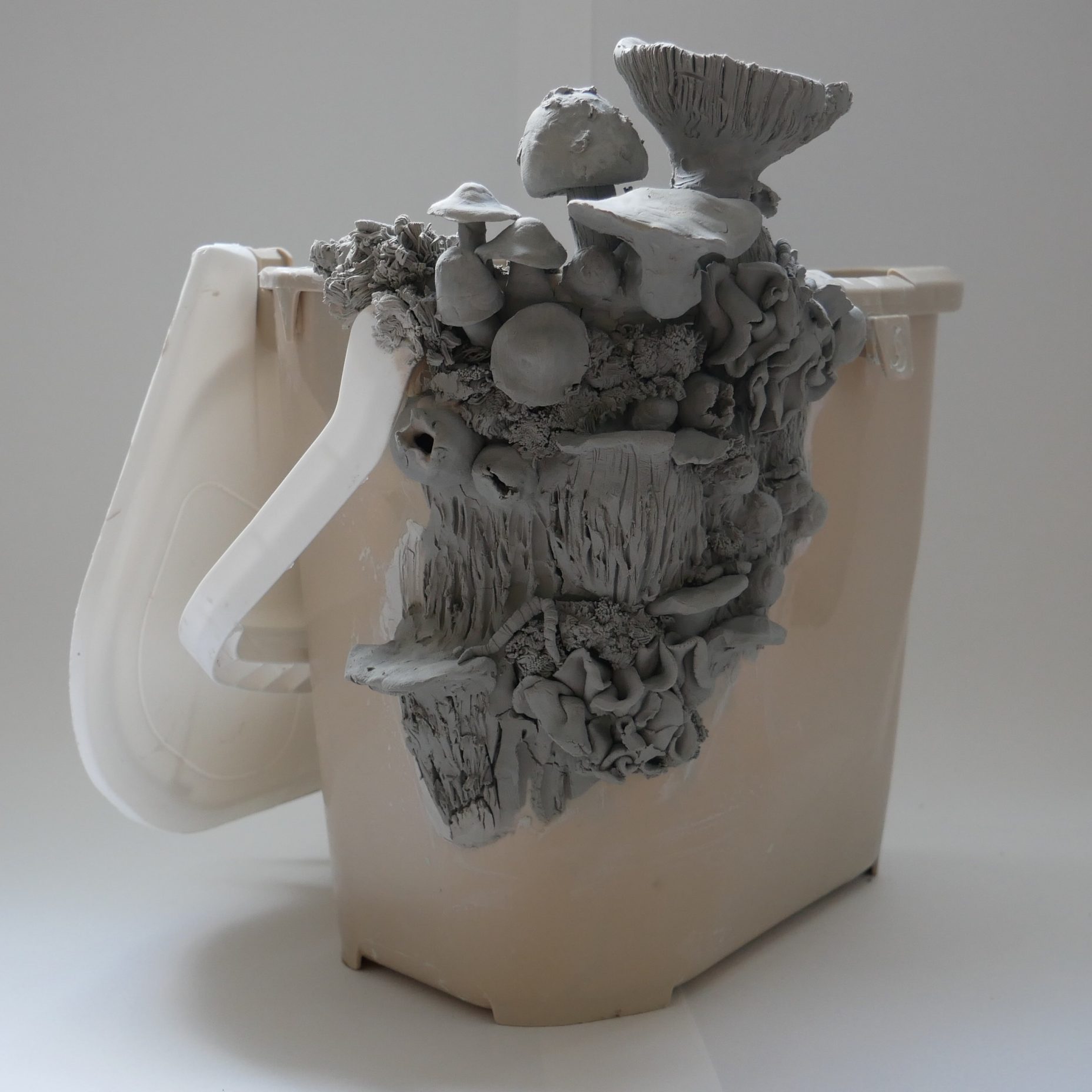
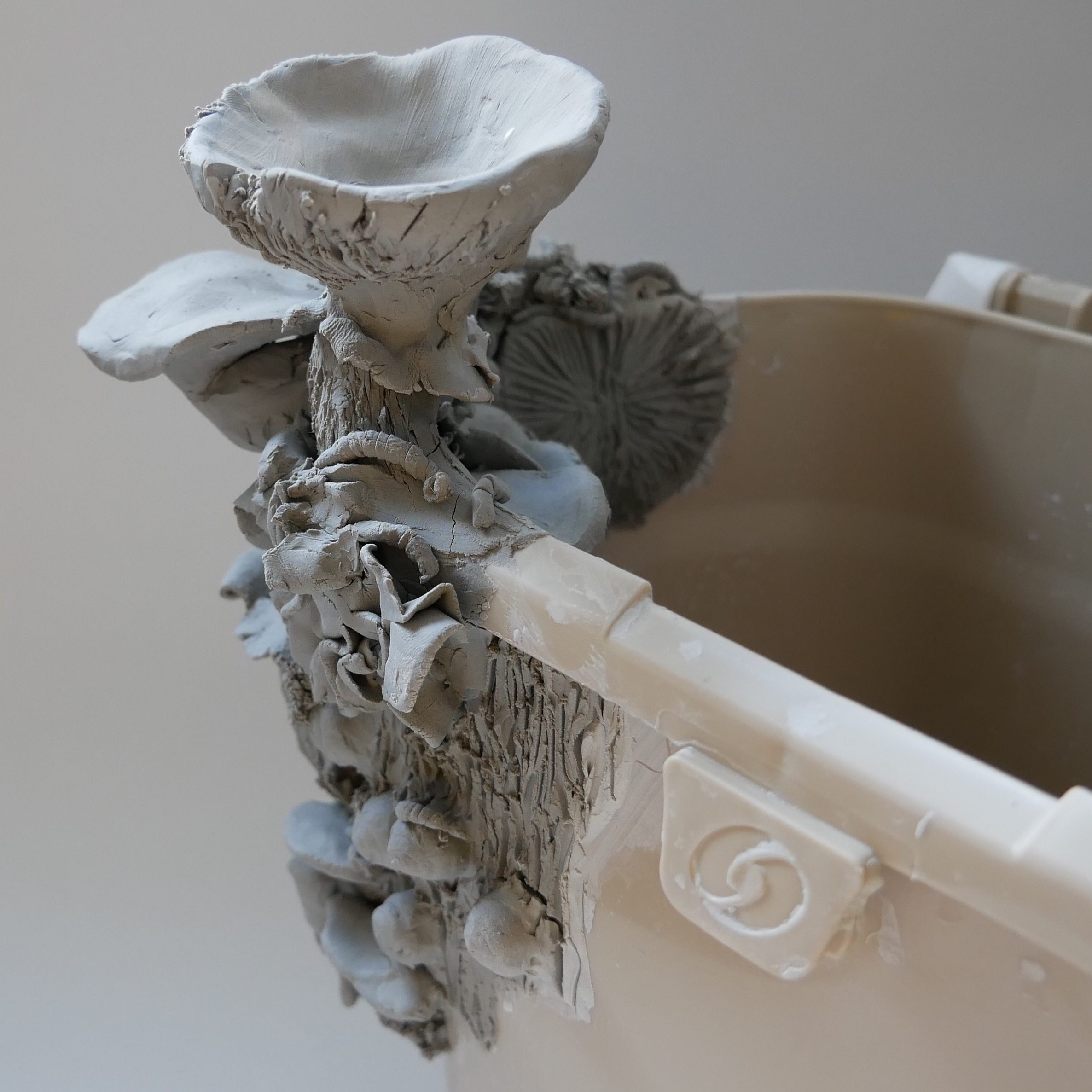
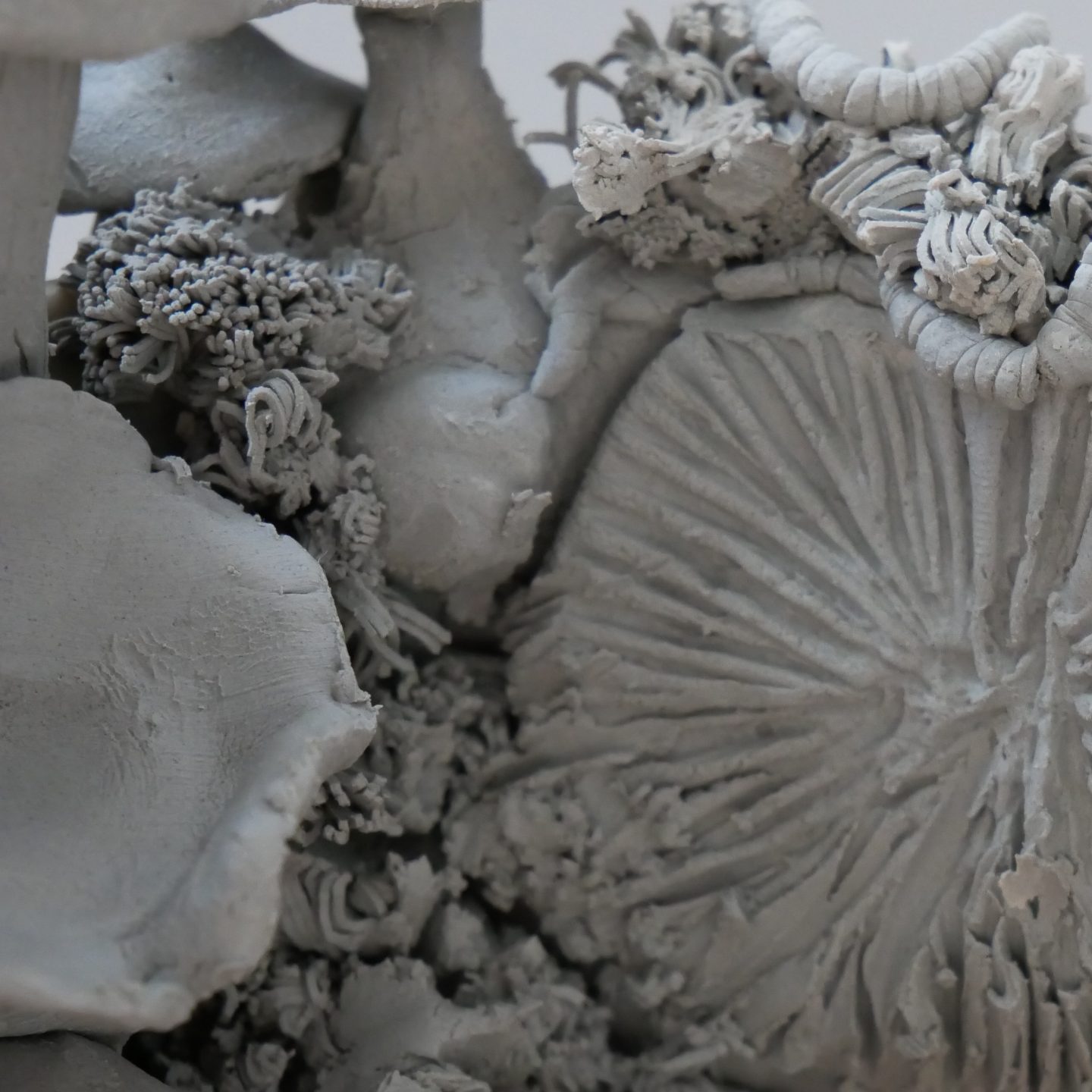
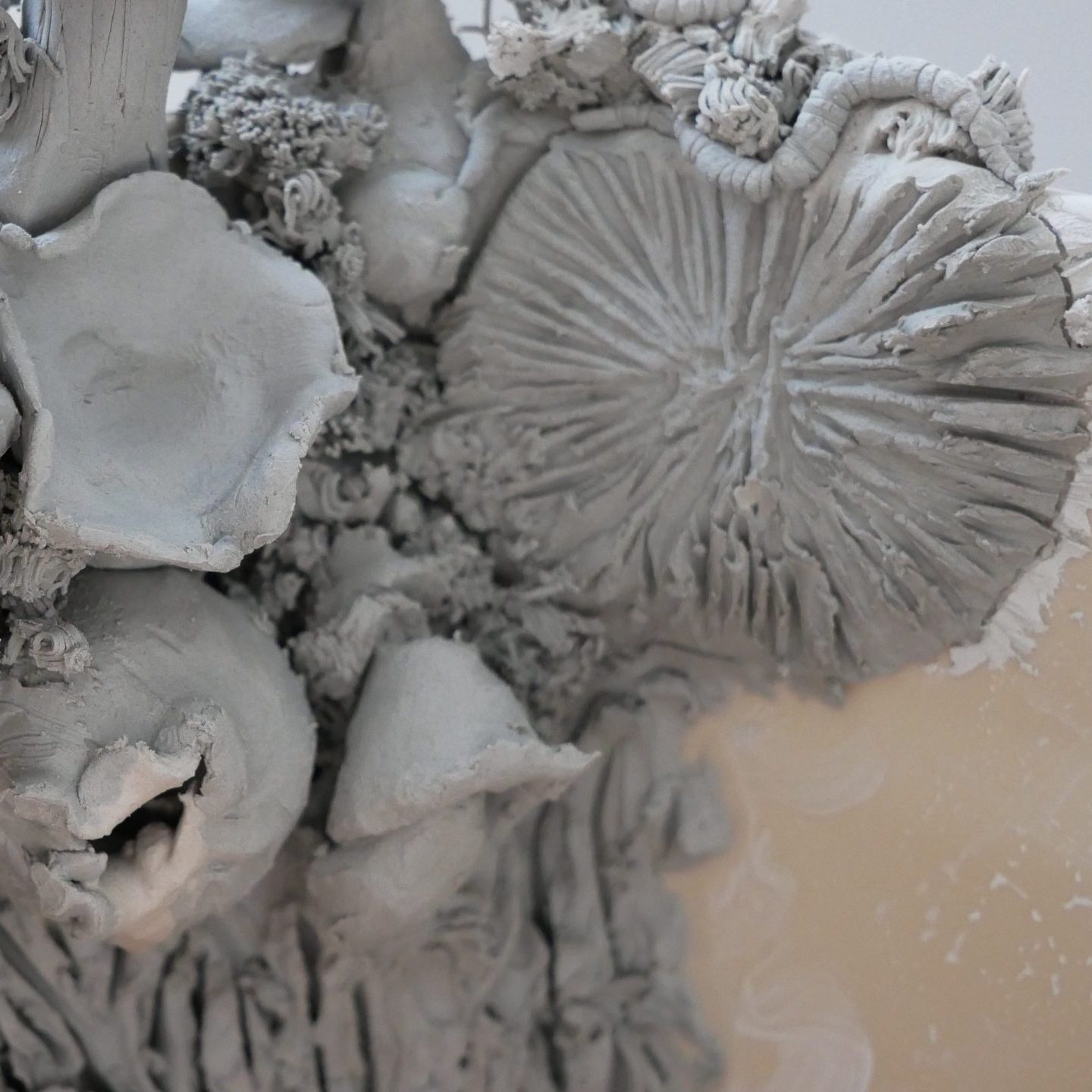
Julia Monaco
4th Year, Major in Art Education
Compost Fungi
14” x 9” x 8”
Unfired Earthenware Clay
2020
Artist Statement:
The word interaction means to affect or influence on another. There is no greater example of interaction beyond the interactions which are naturally occurring. The ephemeral project Compost Fungi aims to explore the interaction between fungi and the ecosystem. Often overlooked, fungi are responsible for breaking down organic matter. Fungi provides carbon, oxygen, and nitrogen to soil, similar to the common elements needed to produce clay. By using unfired clay, a compostable material directly connected to the earth, I was able to create a work that produced no additional waste and will eventually return to the ground where its life can restart.
Description:
Compost Fungi aims to highlight the importance of fungi within the ecosystem. Often overlooked, fungi are responsible for breaking down organic matter. Fungi provide carbon, oxygen and nitrogen to soil, similar to the common elements needed to produce clay. By using unfired clay, a compostable material directly connected to the earth, I was able to create a work which produced no additional waste and will eventually return to the ground where its cycle of life can restart.
Overall, the inspiration for this project began by reflecting on the amount of organic waste produced in a singular household and frequenting local hiking trails. While frequenting local hiking trails, I began to take note of recurring actions, such as fungi emerging from decomposing trees or emerging from rotting foliage. This ultimately led me to question where else fungi thrive. Upon further research it became clear that fungi were also present in compost, mainly in the form of Mycelium.
Since fungi present themselves in compost, I thought it would be relevant to create a sculptural installation on a compost bin showcasing the different types of fungi that may typically grow on rotting or decomposing organic waste. Upon completion of the sculpture, the unfired piece decomposed and returned to the compost bin with other organic waste collected throughout the duration of the project creation.

India-Lynn Upshaw-Ruffner
1st year, Art History and Studio Arts
Auxiliary
54″x72″
Coloured pencil on Fabriano Paper
Artist Statement:
I am a first-year Concordia student in Art History and Studio Arts, with a minor in Sustainability Studies. My interests lie in identity and culture when creating works. I am interested in exploring the connections cultures have to one another, and in certain cases how technology and globalization affect the community where I live and the generation of which I am a part. I am also interested in how the intersectionality of my gender, race and culture impact the various aspects of my life. A field of study that is reflected in my work is post-colonial theory, which examines how colonization has influenced and continues to have an influence on social, political and economic spheres in our lives. I want to foreground my experiences as a bi-racial Canadian woman and reveal how they differ from the assumptions of those with the most power in Western society. In my artwork I seek to provide an alternative to prevailing narratives in the Western world and demonstrate the consequences of not allowing minorities to have a voice. I seek to explore my own identity through my work, while also highlighting the lack of representation and systemic issues surrounding Black people in my society.
Description:
The cellphone has isolated us from genuine connection and feelings of emotional and psychological presence in our lives. We interact with our phones more than ever. The life-sized hands relate to the viewer, providing a reflection of what they are likely doing while observing the piece (texting on their cell phone). The drawing allows the viewer to be placed into “the void”, their hands in front of the drawn ones, and their field of vision filled with white. The viewer’s interaction with the drawing allows them to reflect on their current cell phone usage behaviours, and how it is impacting their life.
The title “Auxiliary” exemplifies the idea of how we have become auxiliary – or secondary – to our phones. The world becomes auxiliary to our experience of it through our phones; the outside wider world has become an addition to the world happening on our screens.